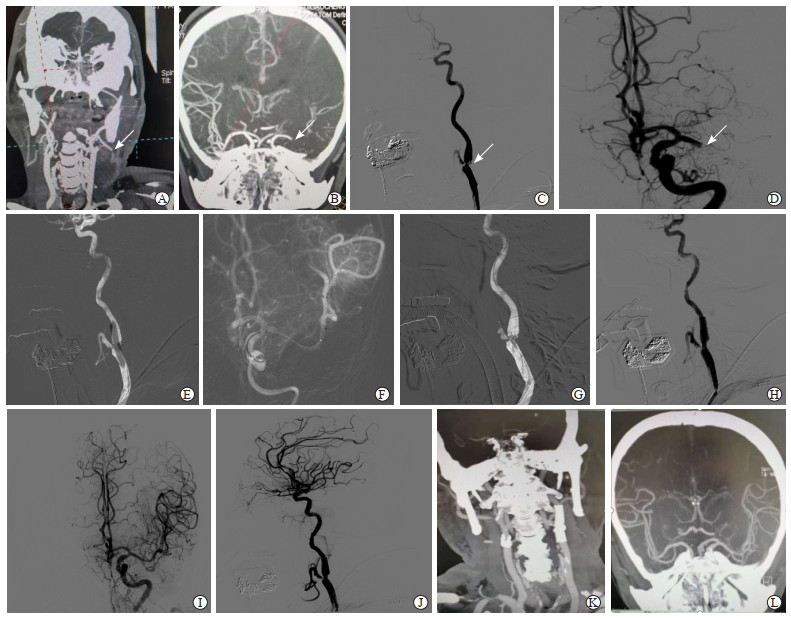| [1] |
ZHU F, BRACARD S, ANXIONNAT R, DERELLE A L, TONNELET R, LIAO L, et al. Impact of emergent cervical carotid stenting in tandem occlusion strokes treated by thrombectomy: a review of the TITAN collaboration[J/OL]. Front Neurol, 2019, 10: 206. DOI: 10.3389/fneur.2019.00206.
|
| [2] |
RUBIERA M, RIBO M, DELGADO-MEDEROS R, SANTAMARINA E, DELGADO P, MONTANER J, et al. Tandem internal carotid artery/middle cerebral artery occlusion: an independent predictor of poor outcome after systemic thrombolysis[J]. Stroke, 2006, 37: 2301-2305. DOI:10.1161/01.STR.0000237070.80133.1d |
| [3] |
BERKHEMER O A, BORST J, KAPPELHOF M, YOO A J, VAN DEN BERG L A, FRANSEN P S S, et al. Extracranial carotid disease and effect of intra-arterial treatment in patients with proximal anterior circulation stroke in MR CLEAN[J]. Ann Intern Med, 2017, 166: 867-875. DOI:10.7326/M16-1536 |
| [4] | |
| [5] |
POWERS W J, DERDEYN C P, BILLER J, COFFEY C S, HOH B L, JAUCH E C, et al. 2015 American Heart Association/American Stroke Association focused update of the 2013 guidelines for the early management of patients with acute ischemic stroke regarding endovascular treatment: a guideline for healthcare professionals from the American Heart Association/American Stroke Association[J]. Stroke, 2015, 46: 3020-3035. DOI:10.1161/STR.0000000000000074 |
| [6] |
GOYAL M, MENON B K, VAN ZWAM W H, DIPPEL D W, MITCHELL P J, DEMCHUK A M, et al. Endovascular thrombectomy after large-vessel ischaemic stroke: a meta-analysis of individual patient data from five randomised trials[J]. Lancet, 2016, 387: 1723-1731. DOI:10.1016/S0140-6736(16)00163-X |
| [7] |
BERKHEMER O A, FRANSEN P S S, BEUMER D, VAN DEN BERG L A, LINGSMA H F, YOO A J, et al. A randomized trial of intraarterial treatment for acute ischemic stroke[J]. N Engl J Med, 2015, 372: 11-20. DOI:10.1056/NEJMoa1411587 |
| [8] |
SAVER J L, GOYAL M, BONAFE A, DIENER H C, LEVY E I, PEREIRA V M, et al. Stent-retriever thrombectomy after intravenous t-PA vs. t-PA alone in stroke[J]. N Engl J Med, 2015, 372: 2285-2295. DOI:10.1056/NEJMoa1415061 |
| [9] |
HAUSSEN D C, TURJMAN F, PIOTIN M, LABREUCHE J, STEGLICH-ARNHOLM H, HOLTMANNSPÖTTER M, et al. Head or neck first? Speed and rates of reperfusion in thrombectomy for tandem large vessel occlusion strokes[J]. Interv Neurol, 2020, 8: 92-100. |
| [10] |
WILSON M P, MURAD M H, KRINGS T, PEREIRA V M, O'KELLY C, REMPEL J, et al. Management of tandem occlusions in acute ischemic stroke-intracranial versus extracranial first and extracranial stenting versus angioplasty alone: a systematic review and meta-analysis[J]. J Neurointerv Surg, 2018, 10: 721-728. DOI:10.1136/neurintsurg-2017-013707 |
| [11] |
BEHME D, MOLINA C A, SELIM M H, RIBO M. Emergent carotid stenting after thrombectomy in patients with tandem lesions[J]. Stroke, 2017, 48: 1126-1128. DOI:10.1161/STROKEAHA.117.016182 |
| [12] |
YI T Y, CHEN W H, WU Y M, ZHANG M F, LIN D L, LIN X H. Another endovascular therapy strategy for acute tandem occlusion: protect-expand-aspiration-revascularization-stent (PEARS) technique[J/OL]. World Neurosurg, 2018, 113: e431-e438. DOI: 10.1016/j.wneu.2018.02.052.
|
| [13] |
CHEN W H, YI T Y, WU Y M, ZHANG M F, LIN D L, LIN X H. Endovascular therapy strategy for acute embolic tandem occlusion: the pass-thrombectomy-protective thrombectomy (double PT) technique[J/OL]. World Neurosurg, 2018, 120: e421-e427. DOI: 10.1016/j.wneu.2018.08.096.
|
| [14] |
JACQUIN G, POPPE A Y, LABRIE M, DANEAULT N, DESCHAINTRE Y, GIOIA L C, et al. Lack of consensus among stroke experts on the optimal management of patients with acute tandem occlusion[J]. Stroke, 2019, 50: 1254-1256. DOI:10.1161/STROKEAHA.118.023758 |
| [15] |
LOCKAU H, LIEBIG T, HENNING T, NEUSCHMELTING V, STETEFELD H, KABBASCH C, et al. Mechanical thrombectomy in tandem occlusion: procedural considerations and clinical results[J]. Neuroradiology, 2015, 57: 589-598. DOI:10.1007/s00234-014-1465-5 |
| [16] |
HECK D V, BROWN M D. Carotid stenting and intracranial thrombectomy for treatment of acute stroke due to tandem occlusions with aggressive antiplatelet therapy may be associated with a high incidence of intracranial hemorrhage[J]. J Neurointerv Surg, 2015, 7: 170-175. DOI:10.1136/neurintsurg-2014-011224 |
| [17] | |
| [18] |
BROEG-MORVAY A, MORDASINI P, SLEZAK A, LIESIROVA K, MEISTERERNST J, SCHROTH G, et al. Does antiplatelet therapy during bridging thrombolysis increase rates of intracerebral hemorrhage in stroke patients?[J/OL]. PLoS One, 2017, 12: e0170045. DOI: 10.1371/journal.pone.0170045.
|
| [19] |
GORY B, PIOTIN M, HAUSSEN D C, STEGLICH-ARNHOLM H, HOLTMANNSPÖTTER M, LABREUCHE J, et al. Thrombectomy in acute stroke with tandem occlusions from dissection versus atherosclerotic cause[J]. Stroke, 2017, 48: 3145-3148. DOI:10.1161/STROKEAHA.117.018264 |
| [20] |
HAO Y, YANG D, WANG H, ZI W, ZHANG M, GENG Y, et al. Predictors for symptomatic intracranial hemorrhage after endovascular treatment of acute ischemic stroke[J]. Stroke, 2017, 48: 1203-1209. DOI:10.1161/STROKEAHA.116.016368 |
| [21] | |
| [22] |
POP R, ZINCHENKO I, QUENARDELLE V, MIHOC D, MANISOR M, RICHTER J S, et al. Predictors and clinical impact of delayed stent thrombosis after thrombectomy for acute stroke with tandem lesions[J]. AJNR Am J Neuroradiol, 2019, 40: 533-539. |
| [23] |
SALLUSTIO F, MOTTA C, KOCH G, PIZZUTO S, CAMPBELL B C, DIOMEDI M, et al. Endovascular stroke treatment of acute tandem occlusion: a single-center experience[J]. J Vasc Interv Radiol, 2017, 28: 543-549. DOI:10.1016/j.jvir.2017.01.007 |
| [24] |
GRIGORYAN M, HAUSSEN D C, HASSAN A E, LIMA A, GROSSBERG J, REBELLO L C, et al. Endovascular treatment of acute ischemic stroke due to tandem occlusions: large multicenter series and systematic review[J]. Cerebrovasc Dis, 2016, 41: 306-312. DOI:10.1159/000444069 |
 2022, Vol. 43
2022, Vol. 43




